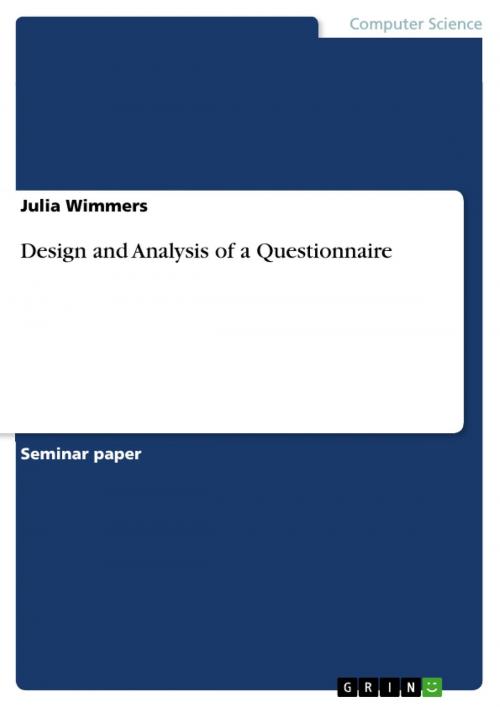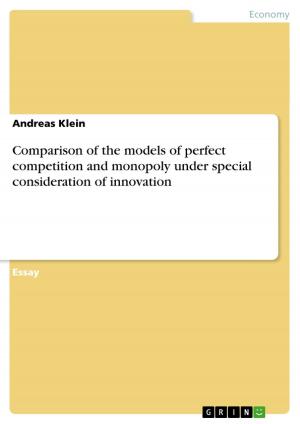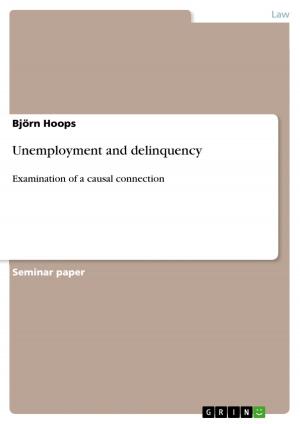Design and Analysis of a Questionnaire
Business & Finance, Industries & Professions, Information Management| Author: | Julia Wimmers | ISBN: | 9783640752690 |
| Publisher: | GRIN Publishing | Publication: | November 16, 2010 |
| Imprint: | GRIN Publishing | Language: | English |
| Author: | Julia Wimmers |
| ISBN: | 9783640752690 |
| Publisher: | GRIN Publishing |
| Publication: | November 16, 2010 |
| Imprint: | GRIN Publishing |
| Language: | English |
Seminar paper from the year 2010 in the subject Information Management, grade: 1,7, University of applied sciences, Munich, course: MBA, language: English, abstract: A reference questionnaire based on the research topic of how 'to prove the market opportunities for a new, non-alcoholic fruit juice drink among younger consumers' is first described and then analyzed in detail. As a questionnaire is one of the most famous methods to gain primary data the author uses the approach to make the examination from general to detail: Within the first superficial description, the simplicity and timelessness of the regarded object of investigation 'fruit juice drink' is proven and some general questionnaire criteria with their corresponding characteristic values like standardized interview strategy, written method of data collection, university students as target group and missing indication on pre-codification are presented. The first 21 questions are clearly focused on content specification, likings of the target group and identification of prevailing interrelations between product preferences as well as buying and consuming behaviour. In contrast to the last question No. 22 which aims at collecting general personal (socio demographic) data of the respondents. The author then splits the core part of the real analysis in four sub chapters, describes and evaluates layout and structure of the questionnaire: five content parts with partly inconsistent alignment of tick boxes and response options. A detailed analysis of nearly all the questions follows then, question No. 8 for e.g. is very laborious created - the respondent has to evaluate six counter parts of attributes in order to classify her or his favourite non-alcoholic drink. Furthermore dichotomous questions are found but sadly no multiple-choice ones. Whereas in the area of scaling, the questionnaire really convinces as it has a mixture of 5% nominal, 75% ordinal and 10% ratio scaling amount of questions, leaving only 10% of unstructured, open-ended questions with no scaling.
Seminar paper from the year 2010 in the subject Information Management, grade: 1,7, University of applied sciences, Munich, course: MBA, language: English, abstract: A reference questionnaire based on the research topic of how 'to prove the market opportunities for a new, non-alcoholic fruit juice drink among younger consumers' is first described and then analyzed in detail. As a questionnaire is one of the most famous methods to gain primary data the author uses the approach to make the examination from general to detail: Within the first superficial description, the simplicity and timelessness of the regarded object of investigation 'fruit juice drink' is proven and some general questionnaire criteria with their corresponding characteristic values like standardized interview strategy, written method of data collection, university students as target group and missing indication on pre-codification are presented. The first 21 questions are clearly focused on content specification, likings of the target group and identification of prevailing interrelations between product preferences as well as buying and consuming behaviour. In contrast to the last question No. 22 which aims at collecting general personal (socio demographic) data of the respondents. The author then splits the core part of the real analysis in four sub chapters, describes and evaluates layout and structure of the questionnaire: five content parts with partly inconsistent alignment of tick boxes and response options. A detailed analysis of nearly all the questions follows then, question No. 8 for e.g. is very laborious created - the respondent has to evaluate six counter parts of attributes in order to classify her or his favourite non-alcoholic drink. Furthermore dichotomous questions are found but sadly no multiple-choice ones. Whereas in the area of scaling, the questionnaire really convinces as it has a mixture of 5% nominal, 75% ordinal and 10% ratio scaling amount of questions, leaving only 10% of unstructured, open-ended questions with no scaling.















